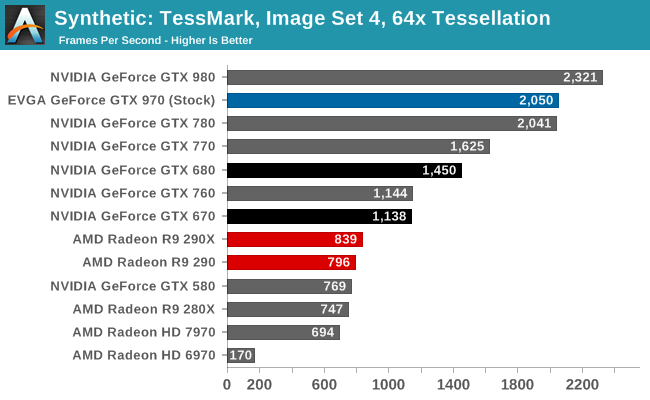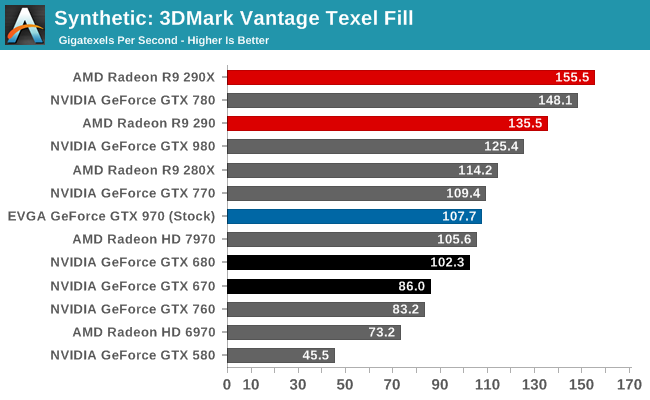The NVIDIA GeForce GTX 970 Review: Featuring EVGA
by Ryan Smith on September 26, 2014 10:00 AM ESTSynthetics
As always we’ll also take a quick look at synthetic performance. These tests mainly serve as a canary for finding important architectural and configuration changes.

Tessellation performance has scaled very closely with the change in SMMs and clock speeds, just as we would expect here.

Texel throughput has also taken a hit in accordance with the loss of SMMs and clock speed. Based on gaming performance the GTX 970 doesn’t appear to be too badly handicapped here, but it definitely doesn’t have much in the way of texel throughput to spare.

Pixel throughput on the other hand ends up being extremely odd and not at all what we were expecting. The GTX 970 takes an incredible dive here, with its pixel fillrate dropping by 26%. At a high level this test is bounded by memory bandwidth and ROP throughput, and both of these factors should be identical between GTX 980 and GTX 970. Instead we see GTX 970 lose more performance than should theoretically be possible, as the 26% drop is more than the accumulated difference between the clock speed and SMM differences.
At this point we’re still trying to figure out exactly what’s going on. We have no other evidence that there’s a difference in ROP throughput or memory bandwidth between the GTX 980 and GTX 970 so it is not clear to us where the difference lies. One possibility is that this is somehow bottlenecked at the Raster Engine level – where each of the four engines accounts for 25% of the work – but the pigeonhole principle means that NVIDIA can’t disable a GPC since at least 1 SMM must be active in each GPC partition. This matter will require further research.










155 Comments
View All Comments
AkibWasi - Saturday, September 27, 2014 - link
ain't those 896(64 per SMM) yellow colored boxes in Titan's diagram indicate FP64 cores ???Ryan Smith - Saturday, September 27, 2014 - link
Correct. NVIDIA only includes those cores on diagrams for their compute/pro GPUs.dexgen - Friday, September 26, 2014 - link
I think it would be a great idea to comment on and analyze the effects of overclocking (extra OC through AB or PX) when even the non overclocked settings end up getting throttled.For me, the most important thing about overclocking when the card is factory overclocked already is how much the throttling changes when the power target is increased. Any comments, Mr. Smith?
Ryan Smith - Friday, September 26, 2014 - link
Increasing the power target helps, but it does not fully alleviate the issue. A 10% increase just isn't enough to eliminate all TDP throttling, thanks in big part to the fact that power consumption grows with the square of the voltage. GM204 would ideally like quite a bit of power to sustain a heavy workload at 1.243v. Which is why that's officially in boost territory, as NVIDIA only intends that voltage/bin to be sustained in light workloads.Alexvrb - Saturday, September 27, 2014 - link
Wow I figured that the 970 would run into far less issues sustaining max boost than the 980. But I guess it is drawing nearly as much power. I don't want to see anyone complaining about AMD cards and boost anymore, heh.Anyway, the 970 still provides the absolute best bang for the buck and I'm stunned they didn't price it at $400. It's fast, reasonably priced, runs cool and quiet. It also is easy on power requirements, though I always overbuy on PSU anyway for headroom. Easy recommendation for anyone buying in the this price range!
AnnonymousCoward - Saturday, September 27, 2014 - link
Square of voltage, what are you smoking? P = IV = I^2 R = V^2 /R. The IC isn't a resistor. Typically current stays close to the same as you increase supply voltage.Ryan Smith - Saturday, September 27, 2014 - link
The formula for dynamic power consumption:P = C * V^2 * f
Where C is capacitance, f is frequency, and V is voltage. Those high boost bins are very expensive from a power standpoint.
AnnonymousCoward - Sunday, September 28, 2014 - link
You're right, thanks! Thinking about it, dynamic power increases by the square, and static is by a direct proportion, so total should be between the two. Dynamic probably dominates so it's probably much closer to the square.Footman36 - Friday, September 26, 2014 - link
What really bothers me is that EVGA is getting lazy, reusing older pcb's. This one looks like a 760... The VRM and phases look very primitive next to a card like the Asus Strix GTX 970. There was a time when EVGA used to wow me with custom designs, the last few years not so much as they invariably use reference boards. the issue I have with most of the reference boards is that coil buzz is noticeable. The Asus and MSI boards are using custom digital VRM's and super alloy caps....Anyhow, nice review.
Iketh - Monday, September 29, 2014 - link
i'm sure it has to do with their big heat sink design + bracing so the card doesn't flex